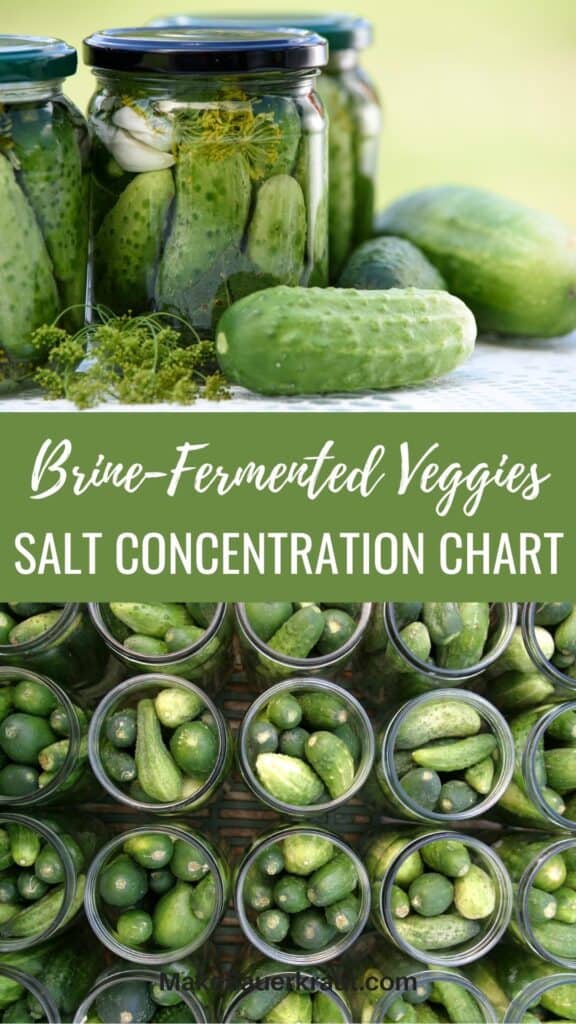If you’re tired of inconsistent results when fermenting pickles, and you’re looking for a reliable way to achieve perfect pickling every time, then this blog post is for you. My Total Salt Concentration Chart will help you make crunchy, delicious pickles every time. Read on to discover the secret to pickling success and learn why my approach differs from the rest.
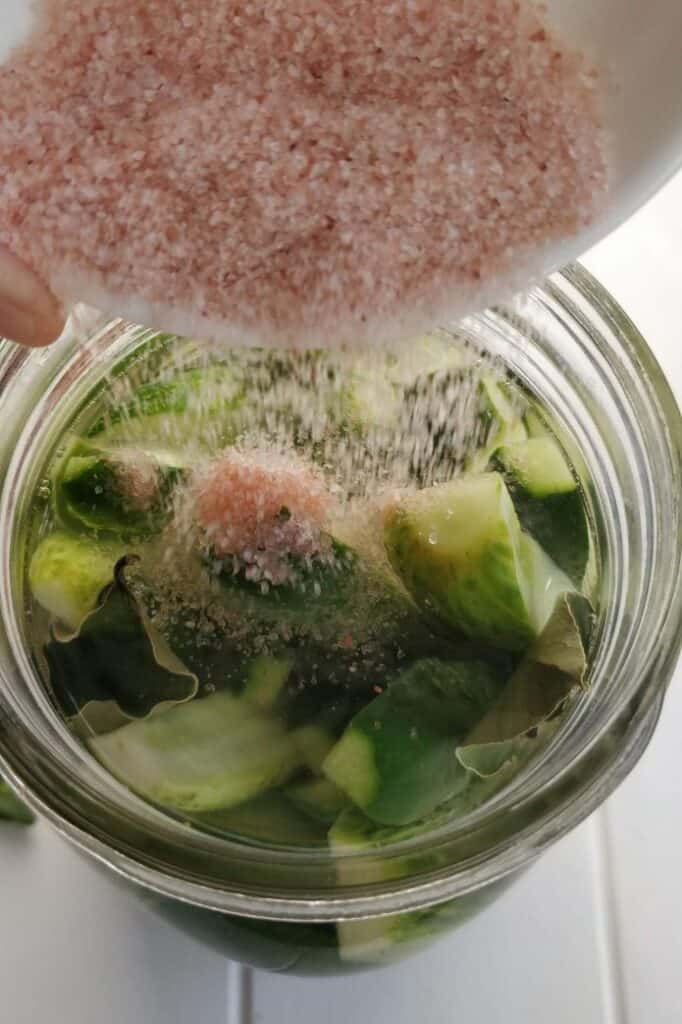
Are you ready to ferment some pickles and want to know how much salt to add?
Are you looking for a brine chart?
I have just the numbers you need for pickling success with homemade brine-fermented vegetables.
But… my “salt brine for pickles” chart is slightly different.
It’s a “Total Salt Concentration Chart.”
What? Why?
To ferment batch after batch of crunchy pickles without getting frustrated by mushy, moldy pickles, you must know the weight of the vegetables and the water in your jar and calculate the amount of salt to add based on that weight.
Once you know this weight, multiply it by the recommended total salt concentration for the vegetables you are fermenting, and then add the correct number of grams of salt to the jar.
Read on to find out how.
Salt Concentration Chart FREE Download
Use the button below to get your own printable Salt Concentration Chart.
The Importance of Salt for Fermentation
Salt is the workhorse in your pickle jar. Bacteria are mineral-hungry and need salt, salt that is rich in minerals.
The right salt concentration is critical for creating the environment for our valuable, mighty microbes to ferment humble vegetables into sour pickles.
- The right amount of salt encourages the right bacteria—lactic acid bacteria—to thrive and grow, giving them a competitive advantage over hostile bacteria.
- Too little salt favors harmful bacteria that can not only turn your vegetables into mush but may cause mold or yeast to grow.
- Too much salt and the lactic acid bacteria will not multiply. You end up with vegetables floating in salty water, not pickles.
What is the right amount of salt?
Do Not Use A Brine Chart!
Hear me out before you hit the BACK button.
My first batches of fermented pickles were made by pouring a salty brine over a jar of packed cucumbers, just like almost all the other online recipes.
Some batches turned out perfect, some moldy. Some of the pickles stayed crispy; others turned to mush.
Why?
I was not using enough salt, and it took some time to figure out why.
I started researching and experimenting and eventually switched to calculating the amount of salt I added based on the weight of the vegetables packed into my jar and the water in there.
That simple switch made all the difference.
You can’t consistently ferment crunchy, tangy vegetables by just pouring a salty brine into a jar of packed vegetables. You rarely end up with enough salt. I’ll show you why in just a moment.
As with sauerkraut, the bacteria responsible for fermentation need a set salt concentration for safe and consistent fermenting.
Use a Total Salt Concentration Chart
You must know the weight of the vegetables and the water in your jar and calculate the amount of salt to add based on that weight.
Once you know this weight, multiply it by the recommended total salt concentration for the vegetables you are fermenting, and then add the correct number of grams of salt to the jar.
Yes, you need a digital scale to do this. The MyWiegh KD8000 is my favorite, though you can find one for around $25. This expense will take your fermentation to a whole new level, and you won’t regret it.
Fermentation is a science that requires tools of the trade: a digital scale.
A 3% Brine Does Not Make a 3% Ferment
My recipes for brine-fermented vegetables are different from most of the other recipes on the internet, which rely on numbers from a brine chart.
Most recipes have you pack your jar with vegetables, mix a salty brine, and then pour that brine into your packed jar.
Results vary because the amount and weight of the vegetables you packed into the jar vary.
Total Salt Concentration Examples
See what happens when I fill one jar with 500 grams of carrots and another jar with 800 grams of carrots.
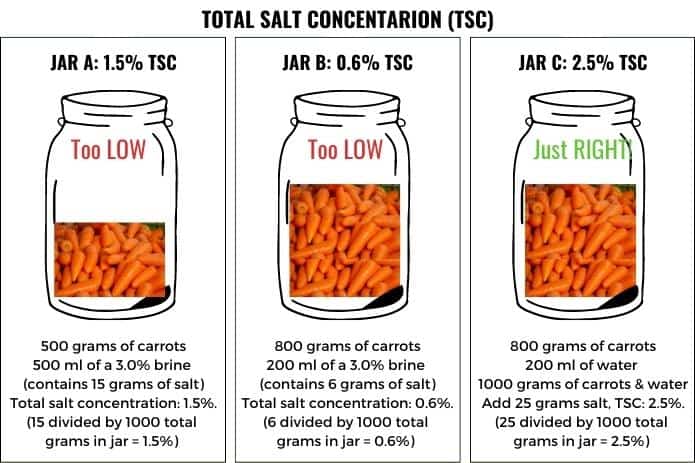
Let’s calculate the Total Salt Concentration (TSC) for each jar.
Jar A (the brine method) is packed with 500 grams of carrots and topped with 500 ml of a 3.0% brine containing 15 grams of salt. The TSC for Jar A is 1.5%.
Jar B (the brine method) is packed with 800 grams of carrots and topped with 200 ml of a 3.0% brine. That brine contains only 6 grams of salt. The TSC for Jar B is 0.6%.
Neither Jar A nor Jar B contains a high enough total salt concentration for safe, mold-free fermentation.
However…
Jar C is packed with 800 grams of carrots and 200 ml of water for a total weight of 1000 grams. Multiply 1000 (the weight of both the carrots and the water) by 0.025 (the recommended total salt concentration for carrots) to get 25, the number of grams of salt to add. The TSC for Jar C is 2.5%.
The perfect salt concentration for the bacteria to ferment simple vegetables into crunchy, delicious, probiotic-rich superfoods.
The right total salt concentration is key for success with brine-fermented vegetables.
Now for the chart with the numbers you have all been waiting for.
Another brilliant bit of sciencey stuff made accessible.
—Cynthia, a grateful reader
Total Salt Concentration Chart
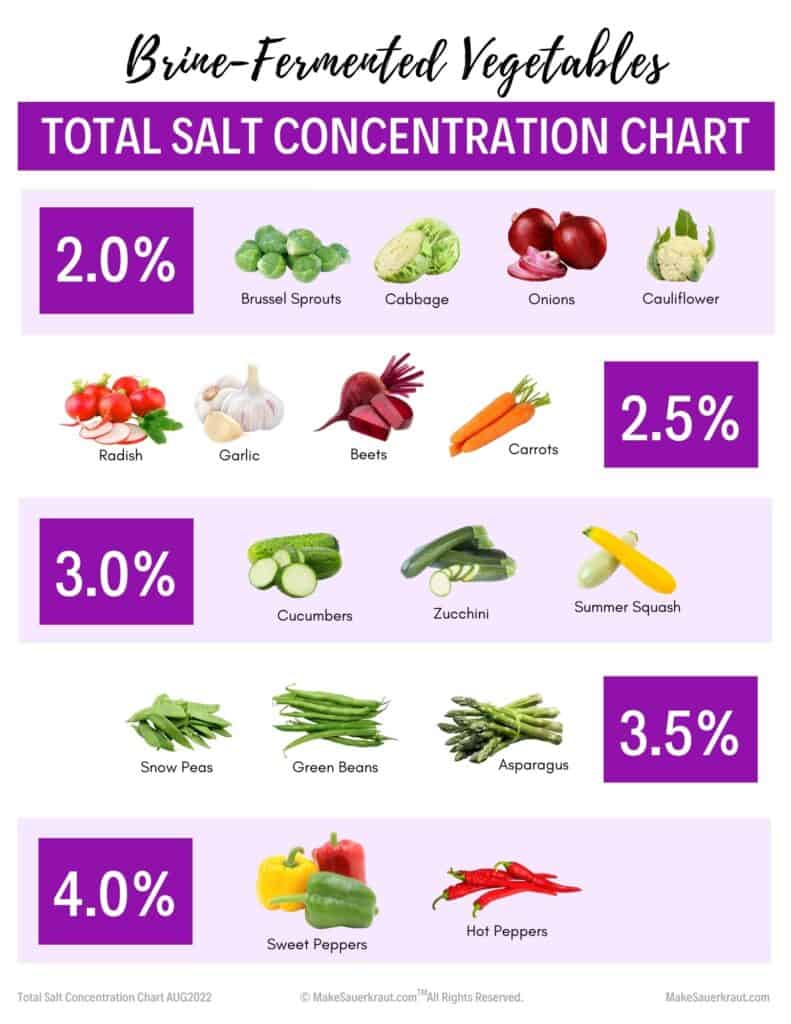
Salt Concentration Chart FREE Download
Use the button below to get your own printable Salt Concentration Chart.
Once you know your numbers, you can take any recipe, whether for vinegar pickles, quick pickles, or fermented pickles, use the seasonings recommended, prepare the vegetables, add water, and then calculate and add the correct total salt concentration.
Below are the total salt concentrations (TSC) I have found to work best for the listed vegetables.
2.0% TSC: Cabbage, Brussels sprouts, onions, and cauliflower.
2.5% TSC: Beets, carrots, garlic, and radish.
3.0% TSC: Cucumbers, zucchini, and summer squash.
3.5% TSC: Asparagus, green bean, and snow peas.
4.0% TSC: Sweet peppers and hot peppers.
The goal is to use a salt concentration that allows you to ferment—without mold or Kahm yeast growing—for two weeks (the amount of time the bacteria need to create enough lactic acid for flavor and health benefits) and end up with crunchy pickles.
Note: I ferment peppers for 4 weeks and garlic for 4-8 weeks.
Since most of these vegetables are harvested during the summer heat, I use an ice chest with a jug or two of frozen water to keep fermentation temperatures between 65-70F (18-21C). It may be a hassle to do this, but fermenting at the ideal temperatures makes a huge difference.
Check out my In A Pickle! online course for all the details on making your own brine-fermented vegetables, along with some hand-holding.
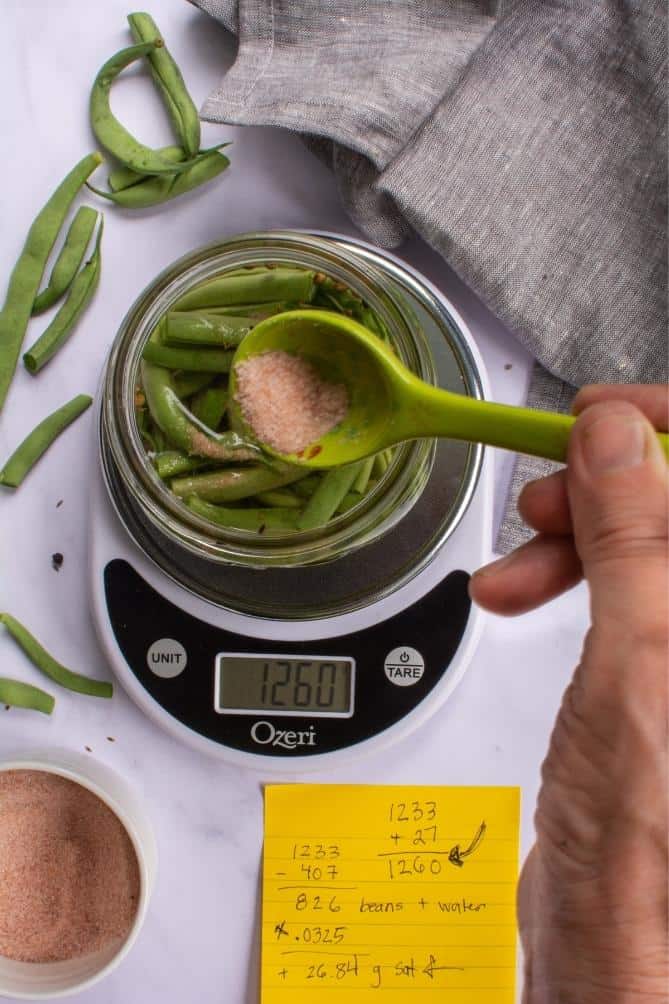
Get ready to be surprised by the wide variety of pickles you can safely & easily preserve at home.
Learn the Perfect Pickle Process in my online program and “grow” your own probiotic-rich superfoods. YUM!
And visit my recipes for fermented cucumber pickles, carrots, or beets that use the right amount of salt, as recommended on my Total Salt Concentration Chart:
Naturally Fermented Pickles [The Complete Guide]
5 Simple Fermented Carrot Sticks Recipes [Crunchy Goodness]
6 Crunchy, Delicious Fermented Beet Recipes [Simple to Make]
And let us know in the comments how you have been doing your salt. Are you game to try Total Salt Concentration,
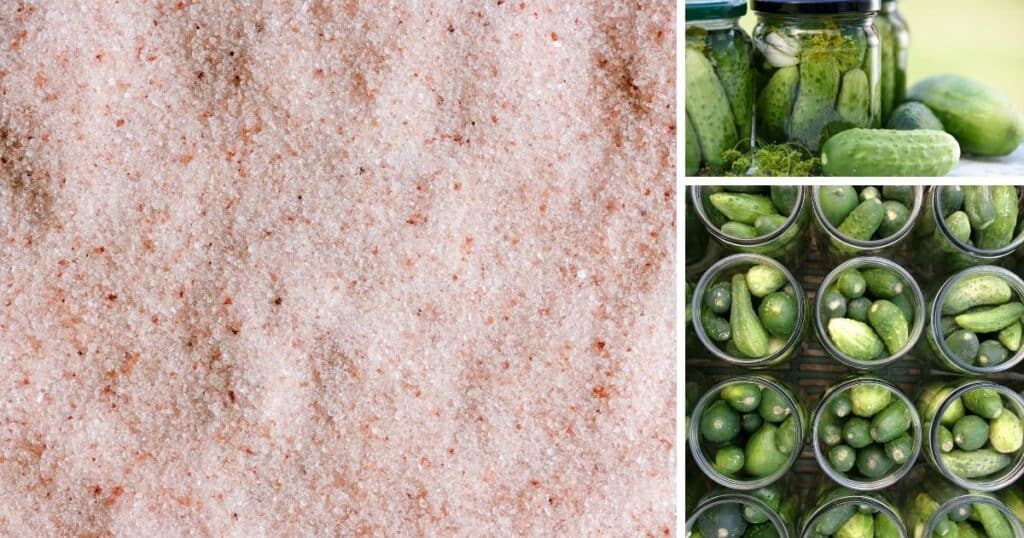

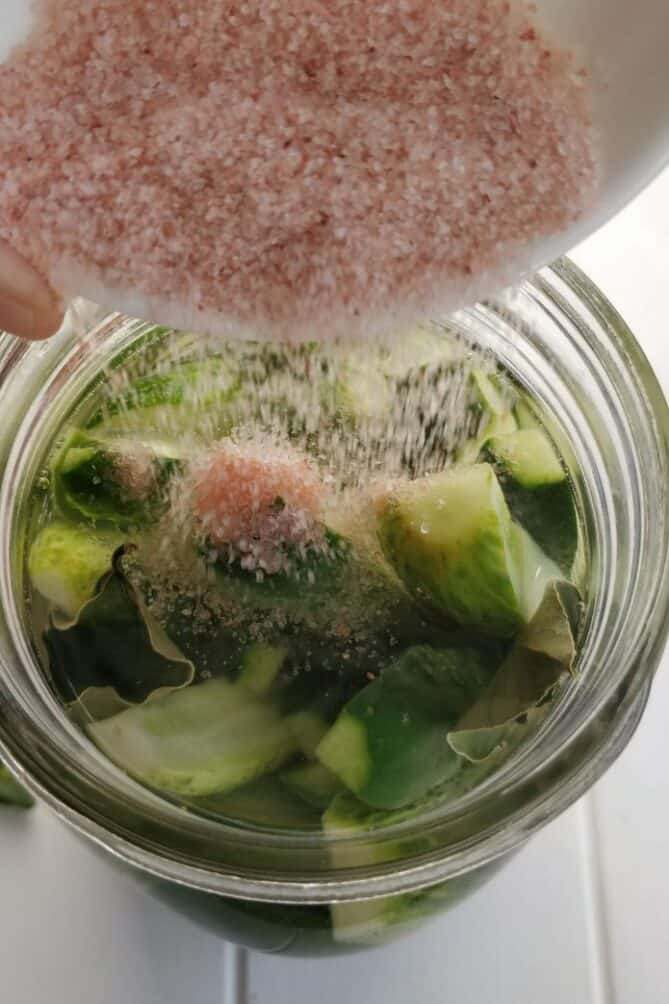

 This post may contain affiliate links which won’t change your price but will share some commission.
This post may contain affiliate links which won’t change your price but will share some commission.